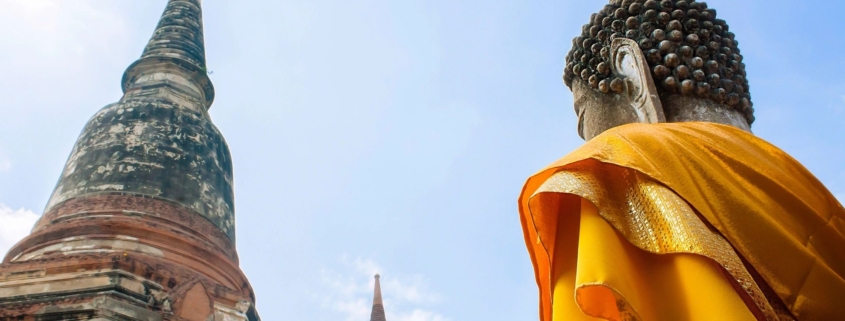5 Common Obstacles to Meditation
The Buddhist tradition notes five main obstacles during meditation. These challenges distract the meditator from the meditation technique.
These hindrances sidetrack the mind away from present moment awareness, preventing relaxation and concentration.
If these obstacles disrupt meditation ongoingly, the long-term meditator may have trouble cultivating the deeper states of compassion, insight, and wisdom that meditation can provide. Quite bothersome and disadvantageous!
The five common obstacles to meditation include:
- Grasping, craving, or desire: daydreaming, craving sweets, thinking about vacations, sensual desires. The mind is distracted by images, visualizations, and cravings for things that are pleasant.
- Aversion or ill-will: judgmental mind, inner critic, not wanting to meditate, general agitation, feeling annoyed by others. The mind is distracted by thoughts and feelings about things that are unpleasant.
- Restlessness: fidgeting with alignment and props, restless body, itching, scratching, busy mind, planning mind, making mental lists. The mind is distracted by constant motion and has trouble remaining still and present.
- Sloth or torpor: sleepiness, tiredness, lack of motivation, foggy headedness, trouble focusing, sluggish body, slouching. The mind is distracted by lethargy or grogginess and has trouble remaining alert.
- Doubt: skepticism, uncertainty, cynicism, wondering whether one is “doing it right,” worry about whether meditation is valuable. The mind is distracted by apprehension and has trouble remaining committed and present.
Which hindrances have you faced recently? Though we tend to encounter the same hindrance again and again, it’s common to bump up against each one at some point. Though it’s difficult to completely eliminate the hindrances, knowing which one(s) distracts you from meditation most often is helpful for reducing its occurrence in the future.
Elevated Doshas and the 5 Obstacles
See how similar these obstacles are are to the elevated or vitiated states of Ayurveda’s three doshas. Here are some common irritations that arise when the doshas are agitated:
- Vata: scattered mind, feeling spacey, restlessness, fidgety body, difficulty focusing, inconsistency, fear, nervousness, ungroundedness.
- Pitta: frustration, anger, aggressiveness, aversion, ill-will, overthinking, criticism, judgmental mind, hot headedness.
- Kapha: lack of motivation, sluggishness, sleepiness, lethargy, foggy headedness, lack of clarity, obstinance.
Notice how similar this list of elevated doshas is to the list of meditation hindrances?
When the doshas are elevated, they contribute to the meditation obstacles—blocking or veiling the natural sattvic state of mind that supports meditation. When out of balance, the doshas play a part in triggering or escalating the five hindrances.
This is important to note, as dosha-balancing diet, lifestyle, and self-care techniques can radically enrich your meditation practice by reducing the hindrances and boosting a state of sattva.
- Sattva: clarity, balance, harmony, ease, order, inner calm. This peaceful mind state supports insight and awakening.
- Rajas: over-stimulated, frenzied, restlessness, spinning, moving too fast, hyperactivity. When disturbed, rajas puts the mind in a hectic, turbulent, overexcited state.
- Tamas: inertia, apathy, torpor, destructiveness, lethargy, laziness. When disturbed, tamas puts the mind in a dull, ignorant, idle state.
See how similar elevated rajas and tamas are to the meditation hindrances?
Extra rajas can directly lead to craving, ill-will, and restlessness. Likewise, extra tamas can directly lead to sloth, torpor, and doubt. To cultivate a consistent and deep meditation practice, Ayurveda encourages reducing excess rajas and tamas, while actively boosting sattva.
How to Enhance Your Meditation with Ayurveda
The meditation path is meant to help us awaken to our own true nature, recognize our interconnectedness, and see clearly into the true nature of reality. Unfortunately, the hindrances are real roadblocks to that awakening—especially when meditators get stuck in a rut repeatedly wrestling with the hindrances.
Although it’s tough to fully overcome the hindrances, it is beneficial to investigate and work with the hindrances when they arise, as that builds mindful awareness, self-regulation, and presence.
When the doshas and gunas are harmonized, the body-mind tends to experience more ease, balance, and harmony.
So, by reducing the hindrances with appropriate diet, lifestyle practices, and Ayurvedic self-care techniques, meditators have a substantially better chance of sitting comfortably, relaxing, committing to the meditation technique of choice, and enhancing concentration—thereby boosting clarity, compassion, insight, and wisdom.
This is an excerpt from Banyen Botanicals publishings.



